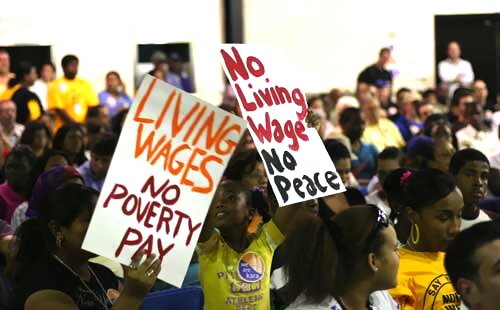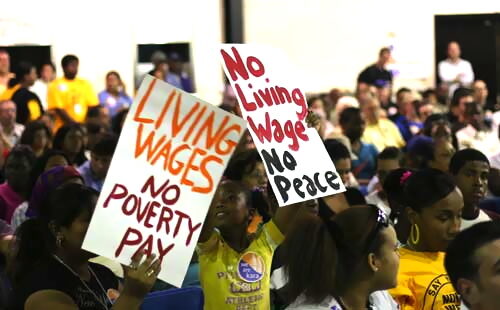
Photo: Kingsbridge Armory Redevelopment Alliance
Both corporate parties accept poverty as a fact of life. Here’s how we can prove them wrong.
First, institute a minimum wage sufficient to provide for life’s necessities. According to Penn State’s Living Wage Calculator, the wage necessary to support oneself and a child in Athens, Georgia, is $15.89 an hour. This contrasts with the current minimum wage of $7.25 an hour, which is insufficient to support even one person without help from tax-funded government programs. A living wage would be a major step toward making work pay for workers—not just their employers—and reducing income inequality in America.
The main argument commonly made against a higher minimum wage is that it would cause an increase in unemployment. But studies have been largely inconclusive, with some showing a negative employment effect, some showing no effect, and others showing an increase in employment. On a national level, Australia has a minimum wage of $15.51 per hour, and a current unemployment rate of 5.2%.
(The New York City Council recently passed a shockingly narrow and watered-down living wage bill that Mayor Michael Bloomberg has threatened to veto. The council has threatened to override his veto. Not that it matters, as it would only benefit 500 city workers—about 0.013 percent of the jobs in the city.)
Others point out that companies will simply raise their prices. This is true, but the increase would be minimal. A U.C. Berkeley study showed that if Walmart raised all wages to at least $12 an hour, their prices would increase by only 1.1%. These increased costs would be spread throughout the income spectrum, while the benefits of higher wages would go directly to low-income people.
It’s unconscionable that more than 30 million full-time workers don’t earn enough to provide for their families. It’s also unacceptable that 22 million willing laborers don’t have access to full-time work. Every human being deserves a job that can provide for his or her family’s well-being. Full employment is possible, but the U.S. government has rejected it as a policy goal because it is not in the best interest of the elites who control Washington.
Thus, the second step toward the eradication of poverty is the creation of a full employment program putting every willing and able American to useful work—by rehiring teachers, rebuilding infrastructure and transitioning to a green future. If there isn’t enough necessary work to employ everyone full-time, that’s a good thing! Our amazingly productive society may not require everyone working 40 hours a week to produce the things we need. One solution, advocated by a number of economists, is to shorten the work week to between 20 and 35 hours. In this way, the work is shared among a larger group of people. Each person can work to provide for his or her family while also enjoying more free time.
Where will we find the money to employ so many at living wages? Any two of the following would be more than sufficient:
1. Cut the military budget by 50% or more.
2. Ensure that the rich and corporations actually pay the listed tax rates.
3. Tax carbon.
4. Create a universal public health care system.
5;. Return the power to print money from the Federal Reserve to the federal government. Additionally, we can save hundreds of billions of dollars in food stamps, TANF (welfare), and unemployment insurance, which would all be unnecessary for those able to work
In FDR’s final State of the Union address, he proposed a Second Bill of Rights, focused on providing a better standard of living for all Americans. The first right he proposed was the right to a job. The second was the right to a living wage. These goals are achievable. The time has come to stop accepting politicians’ insincere excuses and to demand the world that we know is possible. A job at a living wage for every American isn’t a dream; it is our right and we should accept nothing less.
This article originally appeared in The Athens Occupier.









